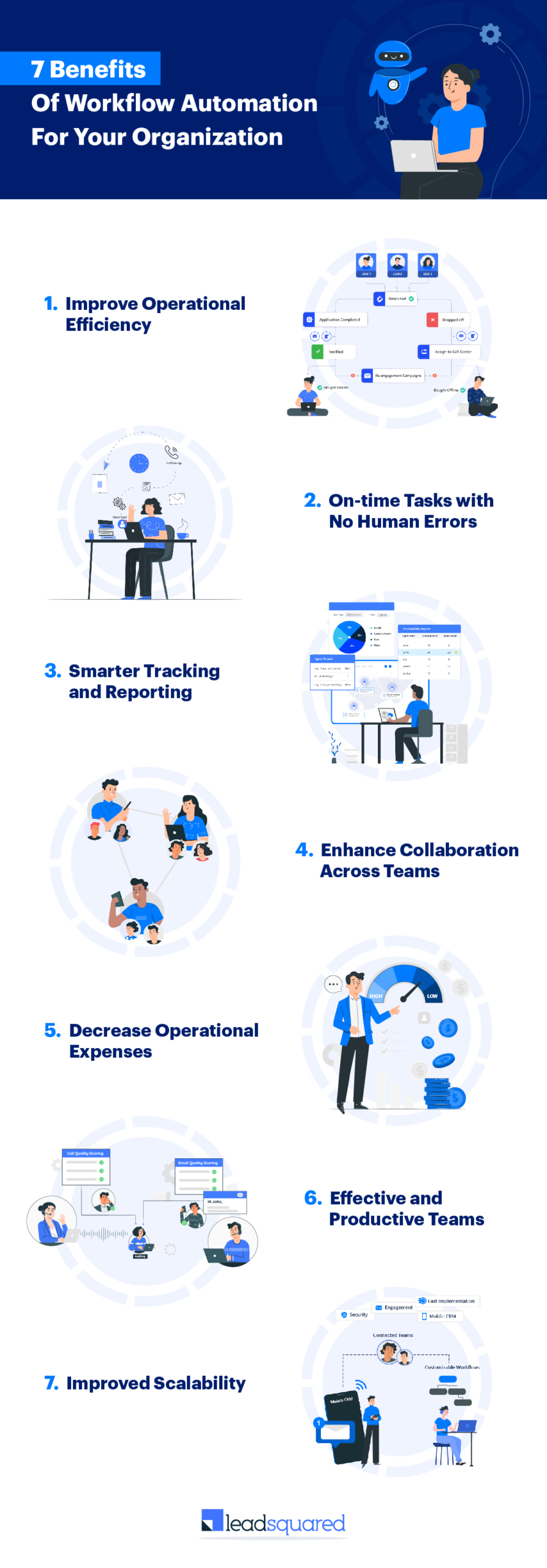Workflow automation is the approach that uses technology to perform repetitive and tedious tasks automatically. It is often used in the industry to perform rote tasks – tasks like data entry jobs, creating and assigning support tickets, verifying applications, and so on.
Industry adoption of workflow automation tools is increasing drastically as it allows brands to stay competitive and serve their clients better. At least one business function in 31% of organizations is automated and more than 1/3rd of businesses have five or more automated divisions.
Because 85% of data is unstructured, workflow automation is crucial for businesses to save time and reduce errors. According to McKinsey, automation may boost global productivity growth by 0.8-1.4% every year. Over the next three years, 90 percent of executives expect their automation investments to increase employee capacity!
Let’s look at why businesses actively seek out opportunities to automate their workflows.
7 Benefits of Workflow Automation
Workflow automation necessitates time and effort to deploy. The organization must first determine the job tasks, develop the relevant rules and logic, then implement the software accordingly.
The rules and logic are often stated as a series of if-then statements that advise the program on what actions to take, and in which order to perform tasks. CRMs and other workflow automation tools can then be programmed to complete the workflow from start to finish, removing the need for any human intervention.
They can design processes that minimize costs, improve job management, shorten process cycles, reduce errors caused by manual entry or oversights, and automate approval and document flows.

1. Improve operational efficiency
This benefit of a workflow automation system is a no-brainer. With workflow automation, routine and repetitive tasks can be automated, eliminating the need for manual handling. This reduces the time and effort required to complete these tasks, allowing employees to focus on more complex and high-value activities.
Workflow automation software can help prioritize tasks based on predefined business rules, ensuring that the most important tasks are completed first.
For instance, your employees can focus on high-value leads while the automation system can nurture and filter all the leads from your marketing campaign. Furthermore, you can provide enhanced support through better communication and shorter wait times.
Workflow automation can automatically assign the customer to the most suitable support agent to improve conversion rates.
For example, CK Birla Hospital automated lead management and nurturing workflows. Here’s what Ashish Anand, Head of Digital Marketing shared,
Deploying an effective automated communication system using LeadSquared helped us improved our conversions by 5X for in-patient leads and 2X for registrations. It is now a key platform we use to manage all our leads.
2. On-time tasks with no human errors
Businesses lose a good number of potentially interested leads when they’re recording data on Excel sheets. A single error in transcribing numbers or email ids results in missed opportunities in the long run. Without automation, your team is re-entering data multiple times—an exponential increase in human errors.
A workflow automation solution streamlines processes by eliminating unnecessary steps. Moreover, such a system can also assist manual workflows by automatically detecting errors. This allows legacy systems to co-exist with newer automated systems during the migration.
By integrating with ERP or CRM solutions, workflow automation systems have real-time access to data to speed up error-free lead capture.
Automating lead capture from landing pages helped us collate registrant information from over 80 masterclasses to build a database of 45-50k students. The processes of admission management and student engagement work seamlessly now.
Sanjay Dhingra, Co-founder and Director, Seed Global Education
3. Smarter tracking and reporting
Workflow automation software can provide real-time visibility into the status of tasks, enabling organizations to identify and address bottlenecks or issues promptly. It does so by providing:
1. A centralized platform to access information
2. Real-time updates on the status of tasks
3. Reporting and analytics tools for tracking performance
4. Customizable dashboards for quick overviews
5. Collaboration tools for team members to share information
A workflow automation tool makes it easier to track progress, prioritize tasks, and stay informed about the progress of workflows. Managers have a hard time monitoring their teams manually. At the same time, teams spend over 1.8 hours a day just searching for the relevant data to create reports. With automated workflows, all the data is tracked which in turn improves reporting. It can effectively bring down your reporting time to under 5 minutes!
4. Enhance communication and collaboration across teams
Is the demo done? Has the quotation been shared? And is the payment done?
Your team doesn’t have to bother about keeping tabs on every lead or following up across internal departments once you have your automations in place. Automatically updating lead stages and dashboards that improve visibility across teams are the first steps that you can automate in your business workflows.
Workflow automation software helps with collaboration by providing a shared platform to:
1. Access information
2. Share real-time updates on task status
3. Use collaboration tools for communication
4. Track tasks and share updates
5. Share documents and information across teams
This improves teamwork by ensuring that everyone has access to the same information and makes it easy to work on documents together.
Learnbay, an edtech platform for data science, synchronized multiple teams with the help of an education workflow automation software. Instead of using disparate tools, their teams now collaborate on a single platform that boosts their productivity. It helped the team focus on growing the business rapidly.
Before automating processes on LeadSquared, we used to rely on 3-4 platforms for email marketing, counsellor management, lead tracking, etc. Now, everything is captured, managed, tracked, and disseminated using the same platform. It increased counsellor productivity by 120%!
Chetna Ahuja, Creative Head, Learnbay
5. Decrease operational expenses
Workflow automation software can help reduce labor costs and eliminate the need for manual data entry and other time-consuming tasks.
By automating routine tasks, businesses can reduce the need for manual labor, decreasing the costs. You can even automate dynamic reports to forecast projections and set targets for teams.
Furthermore, it can help businesses reduce operational costs by:
1. Eliminating paper-based processes
2. Reducing the need for storage and printing costs
3. Lowering the costs associated with manual data entry
Workflow automation software also provides insights into how workflows are performing, allowing businesses to identify areas for improvement and allocate resources accordingly. For example, using automation helped the online learning platform, Digital Nest, increase:
1. Revenue by 10X
2. Lead Volume by 5X
6. Effective and productive teams
Automation streamlines business workflows. Different teams can use templates, workflow stages, forms, and tracking to improve internal and external corporate activities. 43% of businesses even aim to reduce their workflows by implementing automated technology.
Workflow automation software allows businesses to standardize their processes, ensuring that tasks are completed in the same way every time. This reduces the risk of errors and ensures consistency in output reduces the risk of errors.
Workflow automation software can send notifications and reminders to team members when tasks are due or when specific actions are required. As a result, tasks are completed on time and according to the required standards.
Something as simple as automating lead distribution helped Cuemath, an edtech company, reduce their turnaround time (TAT) by 61%!
Before, the TAT for acting upon new leads was 36 hours. Now, it is less than 14 hours. This is a decrease of 61%. Our team is also able to do better follow-ups. They have all the data they need right there, and they also get constant reminders about their next task or meeting. As a result, follow up breaches have reduced by 17%.
Deepak Dutt, AM of Expansions, Cuemath
7. Improved Scalability
Workflow automation tools are designed to scale businesses in several ways. As businesses grow, they need better customization and integration.
Workflow automation tools can be customized to meet the unique needs of different businesses. This means that businesses can start with basic workflows and gradually add more complex workflows as they grow.
Workflow automation tools can also integrate with other systems, such as CRMs, ERPs, or EHRs (for healthcare workflow automation), to speed up tasks and data entry which allows businesses to scale their workflows and collaborative tasks. Workflow automation solutions can handle large volumes of data and tasks without requiring additional resources.
Final Thoughts
Workflow automation systems can drastically improve how your business operates and give you an edge over the competition. LeadSquared’s automation solutions will allow you to create fast and consistent sales processes by automating all back-end and low-value tasks.
It provides a no-code workflow builder so that you can create automated workflows for all your processes without any technical help.
With LeadSquared’s automation, you can use an intuitive and easy-to-use visual designer to automate complex use cases, eliminate repetitive tasks, increase efficiency, and automate lead contact, nurturing, and even conversion.
Get in touch with our team to know more!










